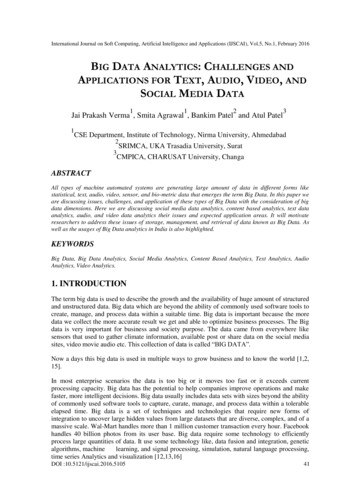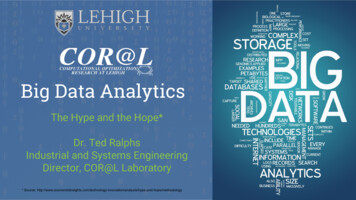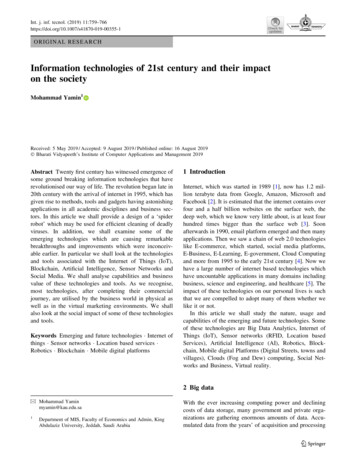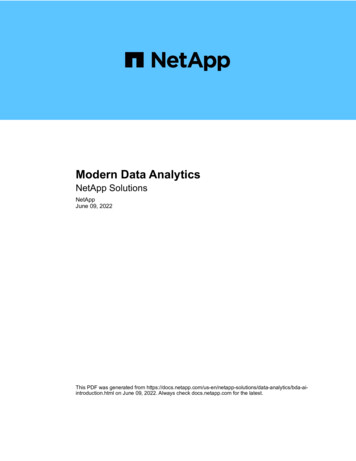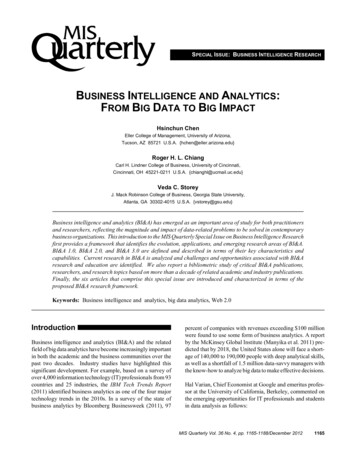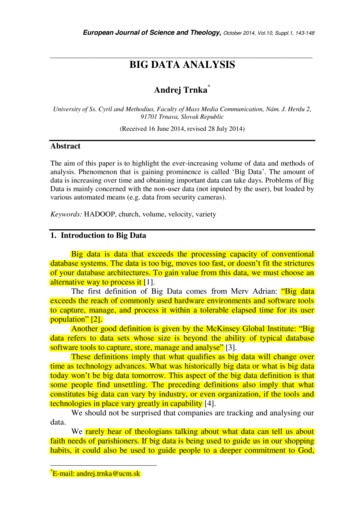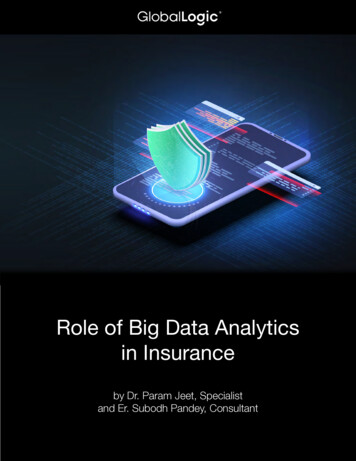
Transcription
Role of Big Data Analyticsin Insuranceby Dr. Param Jeet, Specialistand Er. Subodh Pandey, Consultant
ContentsI n t ro d u c t i o n1What is Big Data?1T h e 3 V ’s o f B i g D a t aC h a l l e n g e i n A n a l y z i n g D a t a w i t h Vo l u m e , Va r i e t y, a n d Ve l o c i t y2What is Big Data Analytics?3The Benefits of Big Data Analytics3B i g D a t a A d o p t i o n i n t h e N ex t 3 Ye a r s3H o w to B u i l d , S to re , A n a l y ze , a n d U s e U n s t r u c t u re d D a t a4Implementing Big Data Analytics Solutions5B i g D a t a U s e Ca s e s i n t h e I n s u ra n c e I n d u s t r y6C o n c l u s i o n9The Role of Big Data Analytics in the Insurance Industry
IntroductionThe insurance industry runs on data and the success of its business model is based on analyzing data toevaluate information and make appropriate decisions. As we know, this is the era of big data. Companiesaround the world have access today to more points of information than at any other time in human history.90% of all the data in the world was created in the last two years. Every day, the planet creates more than2.5 quintillion bytes of information.Every interaction you perform with your computer or phone creates data, whether it’s your phone trackingyour location through its GPS sensors or you posting on social media, shopping with a debit card, orstreaming a song, movie or podcast.What is Big Data?Data that is very large in size (GBs ,TBs, PBs) is called big data. As previously stated, almost 90%of today’s data has been generated in the past 2 years. This data comes from many sources: socialnetworking sites, e-commerce sites, weather stations, telecom companies, and share markets.The 3 V’s of Big DataVelocity: Data is increasing at a very fast rate. It is estimated that the volume of data will double every2 years.Variety: Nowadays, data is not stored in rows and columns. Data is structured as well as unstructured.Log file and CCTV footage is unstructured data. Financial transactions are one example of structureddata.Volume: The very large amount of data we deal with is on the scale of Petabytes.The Role of Big Data Analytics in the Insurance Industry1
Challenges in Analyzing Data with Volume, Variety,and VelocityAn edge computing ecosystem consists of a large number of systems like hardware vendors, platformcompanies, application developers, IoT devices, edge devices, and telecom providers. Apart fromthese, there are two major key players in the ecosystem, i.e., Hyperscale Cloud Providers (HCPs) andOperations Technology (OT) vendors.Amazon Web Services (AWS), Microsoft Azure, and Google are a few HCPs that provide core cloudinfrastructure and platforms. They have thousands of developers working towards building applicationecosystems that can serve multiple enterprises in many sectors globally.It is a distributed landscape where the computing responsibilities are being shared between edge devicesand the central cloud server, thus reducing the load on cloud servers. Edge devices processes someof the data locally and transmits only relevant information to the cloud server for further and complexprocessing. This way, edge computing helps to achieve faster responses to the end device/user, lowbandwidth utilization, etc.An example of the edge computing landscape is illustrated in the figure below.The Role of Big Data Analytics in the Insurance Industry2
What is Big Data Analytics?Big data analytics is the use of processes and tools to glean insights from huge amounts of data. Thisdata is either characterized as high velocity, large volume, or extreme variety. Analyzing this amount ofdata was previously beyond our reach using old tools like spreadsheets.Big data analytics aims to derive conclusions and correlations. This is done with the help of tools likeSAS, Hadoop, R, etc., which are more powerful than our columns and rows.The Benefits of Big Data Analytics Using big data analysis leverages valuable data assets such as unstructured information in the form ofemails, claim notes, etc., which significantly improve enterprise-wide information flow. The aggregation of data is much more important for different and new sources of information.Analytics can be used to effectively leverage partner data, for instance, and allow an enterprise toshare processed data to improve operational intelligence. Despite the lack of face-to-face customer interactions, it is still possible to create an accuratecustomer profile using data aggregated from various sources such as demographics data, socialmedia, public records, etc. A personalized product offer and risk-based pricing can be created by bigdata analytics using different sources of information. The most significant benefit of big data analytics is improved fraud detection. Analytics can help putthe disparate pieces together to identify patterns at the beginning of the claim life cycle so insurerscan protect against fraud.Big Data Adoption in the Next 3 YearsBig data is quickly being adopted across the industry as a tech stack for data warehousing and analytics.The facts below summarize a survey conducted by SNS Telecom IT.It is expected that insurance industries will invest 3.6 billion by 2021 in such technologies. This willcause a 30% increase in better data access to insurance services. It will scale up cost savings by 4070% and there will be a 60% increase in fraud detection rates.The Role of Big Data Analytics in the Insurance Industry3
How to Build, Store, Analyze, and UseUnstructured DataUnstructured data represents around 80% of data. It often includes text and multimedia content.Examples include e-mail messages, word processing documents, videos, photos, audio files,presentations, webpages, and many other kinds of business documents.A strategy for using unstructured data should include the following: A clear view of the data that is being aggregated— different sources and locations, and differentformats. A framework to integrate structured and unstructured data to gain insight A detailed description of the kind of data required—not all available data needs to be collected andused. Aligning business objectives to data collection and its sources to define the goal and the kindof data needed to achieve it will help identify the appropriate data sources and decide what must bearchived or discarded. Data cleansing to ensure that data is accurate and complete. The tools that will be used to extract value from the aggregated data. The presentation of information in a way that people can understand and use. Privacy concerns and policies around the use of personal data.The Role of Big Data Analytics in the Insurance Industry4
Implementing Big Data Analytics SolutionsBig data technologies can be deployed to target either operational efficiencies in IT or an ‘informationadvantage’ for business. In the evolutionary stage, they are best suited to pursuing IT operationalefficiency using the following: Hadoop for ‘Cheap Storage’ and to create an ‘Active Archive’. To build data warehouses that offer ETL acceleration and enterprise data warehouse optimization,resulting in efficiencies and cost savings. Data lakes that use big data/Hadoop to provide a strong data foundation and create a ‘data factory’.As the use of big data technology matures and organizations move towards business transformation, wewill see the following results: Big data being used to manage and process huge volumes and varieties of data. Hadoop 2.0 and NOSQL big data technologies will facilitate real-time data processing and big dataanalytics through self-service BI. Emerging data discovery and data visualization tools will help create business insights and enabletimely actions and interventions. However, to truly leverage the power of big data analytics, insurersmust optimize the triad of technology, processes, and people.The Role of Big Data Analytics in the Insurance Industry5
Big Data Use Cases in the Insurance IndustryThe insurance industry is important for both individuals and companies. Insurance provides stability topeople and their dependents during uncertain times in life. With technology evolving quickly, how we canapply it across industries is an exciting possibility.Pricing and UnderwritingThe insurance business is all about estimatingpremiums for insurance policies, which are basedon the law of large numbers and risk assessmentprocedures.In automotive insurance, the premium calculationfor each policyholder is performed through bigdata analytics by developing complex predictiveanalytics models. These models are very accurateand quick because they use big data technologiesto process large pools of data. Some large ITcompanies like IBM are already supporting suchsystems for insurance companies.Big data also fetches value from external data (social media, newspapers, analyst comments) in order tooptimize their finances and instant payouts.The Role of Big Data Analytics in the Insurance Industry6
Settling ClaimsSettling policy claims is a time-consuming process.It requires manual effort from an adjuster to assessthe loss and recommend whether a claim shouldbe paid or not.In this current era of big data analytics, the claimsettlement process is being improved throughautomation and analyzing historical data to providevaluable information. This is achieved by machinelearning algorithms that use historical claims dataas training data by identifying dependent andindependent variables.With big data, all data is stored in an efficient manner, and analytics are used to score the claims in anorder of priority such that claims with higher levels of complexity get assigned to the appropriate adjuster.These processes save lots of time and help prevent insurance companies from issuing the wrongsettlement amounts.Using these kinds of analytics models, insurance companies can automate decisions such as whether apolicy holder will be given a claim amount or not.Gaining Insight on Healthcare for CustomersThe health insurance sector is a very big businessnot only in Western countries but increasingly inAsia-Pacific regions as well.Oscar, a US-based health insurance company, isutilizing data from medical records aggregators andlinking it with patient medical history. By doing this,it’s helping patients by making permission-basedrecommendations on its user platform. Oscar hasachieved this via implementation of prescriptiveanalytics.Basically, they are applying mathematical models to big data in order to provide recommendations topatients and thus help them with preventive care.For example, suppose a patient living with asthma normally orders an inhaler drug but forgot to do so beforeit ran out. An Oscar nurse can be notified of this situation by Oscar’s telemedicine service, an appointmentcan be arranged with a physician, and the patient can have the prescription filled in a timely manner.This is one example of how health insurers can intervene when patients are at risk.The Role of Big Data Analytics in the Insurance Industry7
Fraud DetectionSimilar to the automation of insurance claimsettlements, a rapid increase in fraud detectioncan be achieved in big data by predictive analytics.The independent variables of a newly filed claimare checked against the variables present in thetraining dataset of previous fraud claims. If a matchis found with high accuracy, a new claim is filedand sent for further investigation.The detection of complex fraudulent claims isdependent on many factors that can be missedwhen using manual human effort, but big dataanalytics can perform these tasks successfully.Threat MappingSetting policy premiums also becomes easywhen big data provides organizations with ampleinformation to analyze. When a customer wants carinsurance, for instance, the insurance companycan analyze information about the areas where theytravel the most, determining the likelihood of thevehicle being damaged or discovering how pronethat area is to road accidents. When an insuranceagency has this sort of information available attheir disposal, they can easily decide how muchpremium they should charge to avoid any losses.The Role of Big Data Analytics in the Insurance Industry8
ConclusionData in the insurance industry is increasing daily, with a 90% increase in the last two years. Insurancebusinesses run on data analysis so they can better decide the price of insurance policies, settle claims,analyze customer behavior to facilitate benefit payouts, detect fraud, and map threats, etc. Big dataanalytics process volume, velocity, and variety in datasets in ways that cannot be done using oldertechnologies. Big data analytics provide many benefits, such as lower processing costs, improving yourpricing, competing with big businesses, focusing on local preferences, and increasing your efficiency,sales and customer loyalty.About the AuthorsParam Jeet is a Ph.D. in Mathematics and has more than 10 years of hands-on industry experience.He has published many research papers in international journals and authored a book. Currently, he isleading AI/ML practice in GlobalLogic, India, and collaborating with universities to enhance the IndustryAcademic research collaboration program.Subodh Pandey - Subodh Pandey is an Engineering Graduate in Information Technology with more than8 years of industry experience. He has done Executive Program in Data and Decision Sciences from theIndian Institute of Technology Delhi. Currently, he is working as a data scientist with one of GlobalLogic’sInsurance domain Client. Also, he is a core member of AI/ML practice in GlobalLogic, India.ReferencesHow Big Data is Changing the Insurance IndustryTop 7 Big Data Use Cases in Insurance Industry — Exastax4 Big Data use cases in the insurance industry you should know aboutThe Role of Big Data Analytics in the Insurance Industry9
GlobalLogic, a Hitachi Group Company, is a leader in digital product engineering. We help our clientsdesign and build innovative products, platforms, and digital experiences for the modern world. Byintegrating our strategic design, complex engineering, and vertical industry expertise with Hitachi’sOperating Technology and Information Technology capabilities, we help our clients imagine what’spossible and accelerate their transition into tomorrow’s digital businesses. Headquartered in SiliconValley, GlobalLogic operates design studios and engineering centers around the world, extendingour deep expertise to customers in the automotive, communications, financial services, healthcare& life sciences, media and entertainment, manufacturing, semiconductor, and technology industries.www.globallogic.com10
As the use of big data technology matures and organizations move towards business transformation, we will see the following results: Big data being used to manage and process huge volumes and varieties of data. Hadoop 2.0 and NOSQL big data technologies will facilitate real-time data processing and big data
